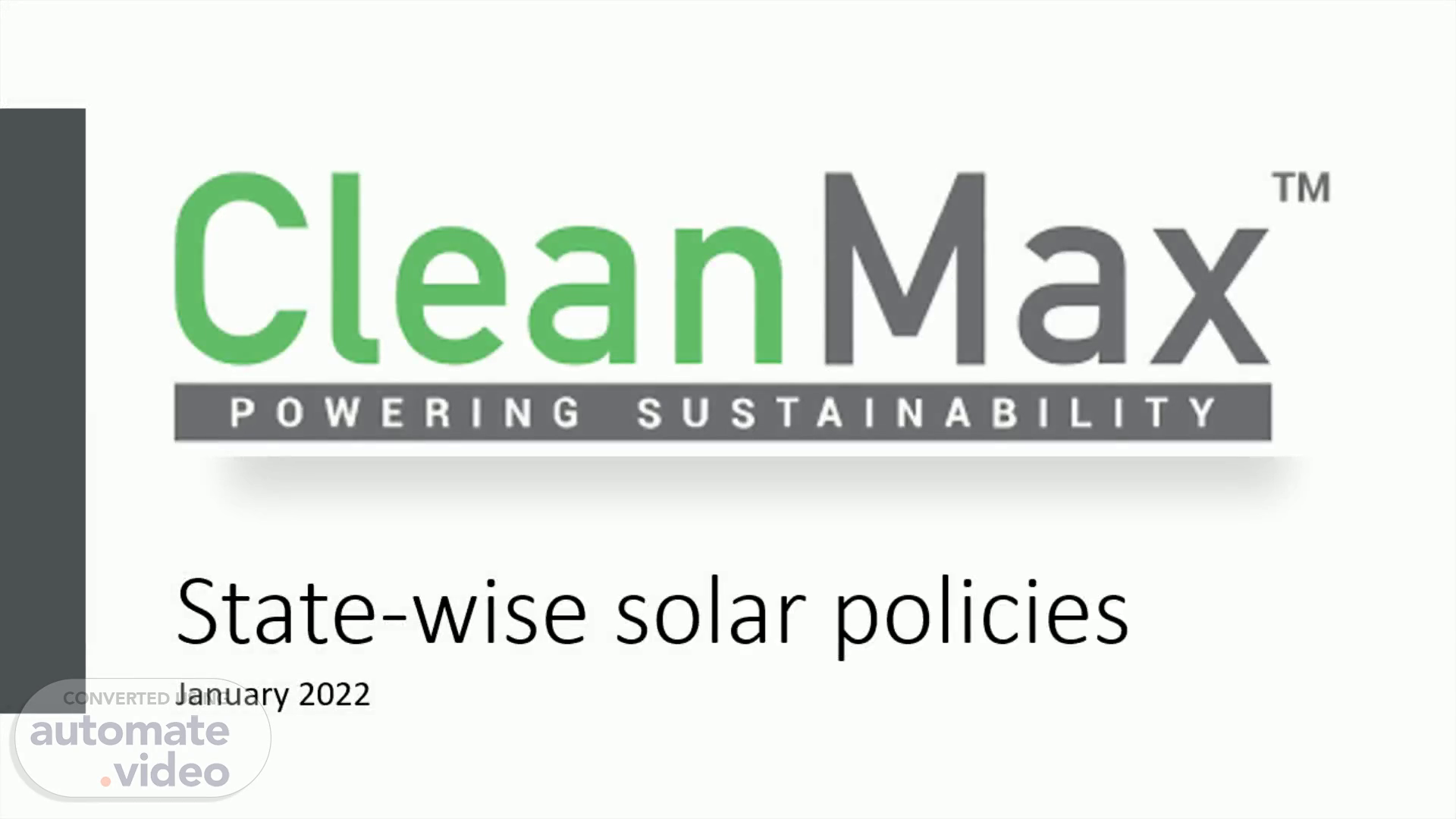
Page 1 (0s)
State-wise solar policies. January 2022. Investors and Stakeholders of CleanMax Solar Power Solutions in UAE.
Page 2 (10s)
RE policy framework in India. The Electricity Act 2003 (EA 2003) provides for regulatory interventions for promotion of renewable energy (RE) sources through a) determination of tariff b) specifying renewable purchase obligation (RPO) c) facilitating grid connectivity d) promotion of development of market The National Tariff Policy (NTP) 2006 requires the State Electricity Regulatory Commissions (SERCs) to fix a minimum percentage of Renewable Purchase Obligation (RPO)..
Page 3 (29s)
RE policy framework in India. In view of the aforesaid provisions, regulatory framework for renewable power is evolving and all major States, Central Electricity Regulatory Commission (CERC), Central Electricity Authority (CEA), etc. are declaring, revising, and modifying renewable power regulatory framework on a regular basis. These include RE policy RPOs Feed in Tariffs ( FiTs ) Renewable Energy Certificate (REC) mechanism grid connectivity and forecasting provisions etc..
Page 4 (49s)
CleanMax helps you make informed decision. Such multiplicity of agency structure, frequently updating policies and regulatory framework creates confusion among existing/potential RE users. What is net metering? How does it help my project? Which state offers the highest benefits for setting up RE project? What is the minimum criteria for availing RE project benefits? Which authority approval is required for my RE project? As sustainability partners of corporates and other commercial users, we at CleanMax , have taken the onus to simplify this information and eliminate the confusion regarding state-wise policies for solar power..
Page 5 (1m 15s)
State-wise policies for Rooftop Solar projects.
Page 6 (1m 23s)
Summary of state-wise approval criterion. State MH UP RJ KA HR TN DL TS GJ AP WB PY Net metering* range 1 kW–1 MW 1 kW–2 MW 1 kW–1 MW 1 kW–1 MW 0–1 MW Consumers under Low Tension category 1 kW – NA # 1 kW–1 MW 1 kW–1 MW 1 kW–1 MW 5 kW–not specified NA–500 kWp Rooftop banking norms YLY YLY YLY MLY QTRLY YLY YLY HYLY YLY QTRLY YLY YLY Approval authority (CEIG/CEA) a a a a a a a a a a a aa Net metering option 1 2 1 1 3 3 3 3 3 3 3 1 Other approval criteria NA NA NA NA NA Ministry clearance; Reverse Test Report from Distribution utility NA Netmetering agreement to be executed within 15 days of approval; SPV system to be synchronised within 10 working days Opex projects not allowed; only capex projects considered NA NA NA.
Page 7 (1m 55s)
Summary of state-wise benefits and charges. State MH UP RJ KA HR TN DL TS GJ AP WB PY Benefits Banking, Wheeling, Losses, Cross subsidy, additional surcharge, etc. Wheeling and Cross subsidy Wheeling, Banking and cross subsidy surcharges Transmission, wheeling for rooftop solar Electricity taxes, cess, duty, cross subsidy Transmission, wheeling for rooftop solar (to the extent no wheeling) Wheeling, Banking and open access Transmission and loss, wheeling and loss, cross subsidy surcharge, additional surcharge, CDM benefits - 100% in 1st year, with 10% reduction in benefit each year, so as to charge 100% in 11th year NA Distribution losses and charges Transmission and wheeling Transmission and wheeling Specifically chargeable fees Statutory fees, testing fees, Supervision charges, application fees NA NA Banking and wheeling charges applicable for Ground mounting projects Transmission, wheeling and banking NA NA NA Statutory, testing, supervision, application All other chagres NA NA.
Page 8 (2m 35s)
Thank you.